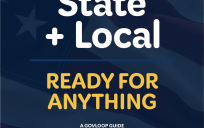On April 30, 2010, over 200 public and private sector participants convened at the Department of Housing and Urban Development to think big about how the Government can learn from the emerging trend to use prizes and competitions to solve some of the grand challenges of our time. This event, led by Robynn Sturm from the White House’s Office of Science and Technology Policy, built on the President’s Innovation Agenda and the Open Government Initiative by stressing some key concepts:
- We have an opportunity to identify and scope problems and national challenges like never before;
- There are many ways – some traditional and some relatively new – to identify a variety of possible solutions to those challenges;
- The process employed to develop those solutions could lead to innovations that have never before been possible; and
- The government has an opportunity to strategically leverage the principles of Open Government (transparency, participation and collaboration) to drive and support these innovation efforts.
Throughout the day, an impressive lineup of thought leaders and practitioners shared their expertise and knowledge about these core concepts—some far-reaching and some refreshingly practical—with the Government-focused audience. With a waitlist as long as the attendance list, the event was structured to capture knowledge for the folks that couldn’t attend through liveblogging, tweeting, webcasting, and content repositories. Beth Noveck and Aman Bhandari liveblogged on the keynote speakers’ presentations and the lunchtime interview with Vivek Kundra, the US Chief Information Officer. Several attendees tweeted throughout the day under the hashtag #opengov. The Case Foundation, co-sponsors of the event, provided live webcasting on their Promoting Innovation webpage, from which they will generously provide all the materials and video from the event.
Already, attendees are beginning to share their impressions of the event. Micah Sifry, the co-founder of the Personal Democracy Forum, captured his thoughts in a blog post on prizes, challenges and government innovation. In that spirit, this post summarizes some of my key take-aways from attending the event. In addition, I would highly recommend that you take the time to read through the resources listed at the end of this posting—they are invaluable to understanding the President’s vision for innovation, the potential for prizes to drive innovation in government, and the linkages between innovation and Open Government.
I took several important lessons from Jonathan Bays, a Consultant in McKinsey & Company’s Social Sector Office and one of the keynote speakers, including:
- Prizes don’t need to be monetary or recognition-based. McKinsey’s report on prizes describes six different types of prizes that create value and change.
- There are many reasons why prizes work; it’s not just the money. Goal, Glory, Guts, and Gold all motivate participants.
- A surge in capital has become available for prizes over the last decade— at an 18% growth rate per year. With more funding comes an increasing opportunity to leverage these methods to solve more problems.
- Prizes can and should be combined with other traditional funding mechanisms (like grants and contracts) if the problem solvers can’t accept all the risk associated with pursuing a solution. For example, the targeted use of grants can push possible solvers through the proof of concept phase.
- Prizes are only part of the “portfolio of actions” directed at the overall aspiration. After the challenge/competition is conducted it is critical to continue to build the legacy and reinforce the impact.
The first keynote speaker, Peter H. Diamandis, the Chairman and CEO of the X Prize Foundation, also shared some important observations about the value and operation of successful prizes:
- Prizes have the potential to apply a significant multiplier to the initial investment. Peter has observed that prizes incentivize the investment of resources at a rate of 10-40x the prize amount. For example, the teams that competed for the $10M Ansari X prize collectively invested over $100M in their efforts.
- Prizes reinvent philanthropy and procurement by changing the paradigm about how much value can be created for each dollar invested. Many non-profits are accustomed to a 30-cent return on the dollar, whereas prizes have a multiplier effect.
- Great prizes that aim to expose solutions to grand challenges require a long term commitment. Some of the most revolutionary prizes have taken 3 to 8 years to demonstrate progress.
- Visionary prizes grow industries by mobilizing capital, encouraging the definition of multiple viable solutions to problems, encouraging those solutions to be brought to market and compete for business, and creating profit and jobs.
The great challenge for the audience that attended the event on Friday is to translate those lessons into a viable approach for the government to strategically leverage the potential of prizes. The federal government faces many unique challenges in this space:
- The vast majority of agencies’ authorized funds focus on contracts and grants as the primary means for partnering with non-governmental entities. Over $1 Trillion is authorized for grants and contracts in the President’s budget, with only a small fraction of those funds able to be used for innovative means, such as prizes and competitions.
- Many agencies lack the partnership authority to create the optimal arrangement of public and private partners to tackle their most pressing problems.
- The default problem solving mentality of the government focuses on leveraging internal expertise and resources, grants, contracts and/or other formal arrangements. Prizes are not typically considered as a viable option.
- Federal employees are neither empowered to nor tasked with identifying and managing innovative ways to partner and solve problems.
Despite these challenges, this is an extremely exiting time for the federal government. This is a time where innovation, public-private partnerships, and technology solutions are creating a perfect storm for generating huge leaps in solving the grand challenges of our time, including: energy and the environment, development and human rights, transportation, health, education, exploration, and life sciences. We have the opportunity to inject disruptive thinking into the way the government organizes to deliver results. The White House is committed to helping the federal government overcome its challenges, leverage lessons learned and best practices from the private sector, and identify new opportunities for innovation. In fact, Beth Noveck closed the event by announcing that a new community of practice, led by the White House, will be formed around this topic to keep the conversation/inter-agency collaboration going.
We look forward to joining that dialogue and helping to move the Innovation Agenda forward.
Key Resources:
The White House’s “A Strategy for American Innovation: Driving Towards Sustainable Growth and Quality Jobs”
OMB’s “Open Government Directive”
McKinsey’s “And the winner is…: Capturing the Promise of Philanthropic Prizes”
Knight Foundation’s “Information and Communication Contests: An Analysis”
OMB’s “Guidance on the Use of Challenges and Prizes to Promote Open Government”
Examples of Innovation and Prizes in Action:
Department of Education Innovation Portal
Ashoka’s Changemakers
XPrize Foundation
Apps for Democracy
Originally posted on Phase One Consulting Group’s transformation in the federal sector blog.




Leave a Reply
You must be logged in to post a comment.